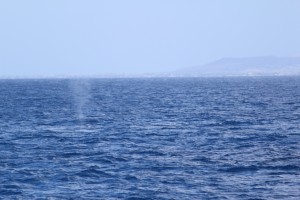Today, our mission was simple: to understand ecotourism, we became ecotourists. To that end, we joined 75 tourists aboard the luxurious 140′ Navatek I, operated by Atlantis Adventures in Waikiki, for a humpback whale watch morning cruise. “Luxurious” is not a word many of us would use to describe a typical whale-watching vessel, but as Dr. Read explained, the Navatek I is mostly catering to tourists staying in Waikiki’s pricey resorts. With expectations to meet, the Navatek I is equipped with air-conditioned cabins, multiple viewing decks, a full bar, plentiful add-on meal items, and “state-of-the-art SWATH technology (Small Waterplane Area Twin Hull)” (http://www.atlantisadventures.com/waikiki) that makes the boat, when moving, feel almost as stable as a moving car.

In our pre-board class briefing, Dr. Read asked us to be thoughtful about the type of people this kind of cruise might attract. We were encouraged to watch people, not whales–or, rather, to watch people as they watched whales. Would there be shrieks of excitement with each whale sighting? Would we be surrounded by avid wildlife photographers with sophisticated cameras, or would we encounter tourists with smartphones and selfie-sticks? We were told to be inquisitive, to wonder about the motivations and interests of tourists who might never get any closer to nature in Hawaii than when on this luxurious ship. Once we were on board, the Navatek I’s naturalist gave a quick overview of humpback whale biology, with a special emphasis on size. Emma and Laura volunteered to hold up artificial made-to-scale humpback whale flukes, stretching 15 feet wide, to provide everyone with some perspective on just how large humpback whales really are (adults are 40-52 feet long and weigh up to 45 tons!).

The naturalist also told the audience about the humpback whales’ annual migration from their summer feeding grounds in Alaska to their winter breeding grounds in Hawaii’s warm waters. Although much of the winter population is concentrated in the Auau Channel off the west coast of Maui, there are plenty of whales who choose to spend the season (December through May) relaxing in the waters of other Hawaiian Islands, including Oahu. As the naturalist concluded her speech, another staff-member stepped up to provide a Japanese translation for the many Japanese tourists aboard. Soon, the Navatek I pulled away from the dock, and we joined the throngs of people headed outside to search for whales. It wasn’t long before we spotted the distinctive blows of breath of a mother and calf pair, who the Navatek I casually followed for the remainder of the two-hour cruise.

Given the whales’ lack of surface activity, many of us were surprised by the Navatek I’s reluctance to depart in search of other, potentially more active whales, but it seemed that the boat’s captain simply meant to check the box in an imaginary checklist: seen whales? check! (mission complete). Since the whales mostly stayed beneath the surface, the Navatek I’s passengers spent long stretches of time staring at a seemingly blank expanse of ocean, wondering when and where the next misty whale breaths would appear– and just as quickly disappear.

There was nothing to cause a splash: no tail slaps, no pectoral fin slaps, no breaches—and although it was serene, we wondered whether this type of whale-watching would be enough to inspire a conservation mindset for first-time whale watchers. Would they grow bored with the whales, tune-out the persistent chatter of the naturalist, and turn to their cell-phones for alternative entertainment? And with the developed coastline of Waikiki never out of sight, a constant passage of ship traffic, and the scent of pollution in the air, could it really be possible for these tourists to leave feeling awed by the majesty of nature? How might the Japanese tourists’ perceptions of whaling be changed by the experience? Would a smaller whale watch boat such a zodiak, that carried passengers closer to the water surface, and perhaps occasionally sprayed them with waves of salty sea water, be a more immersive and impactful experience?
Throughout the course of the morning we asked ourselves a dozen such questions, but these are the sort of questions that are impossible to answer in a definitive, one-size-fits all way. Yes, there were people who shrieked with excitement with each sighting of a whale’s flukes, but there were also plentiful cellphone users. Despite a lack of clear answers, the trip was a tangible way to face the reality of managing coastal species along an urban and highly touristed coast. And though we might question the conservation message provided by an artifical-feeling whale watch, at least the Navatek I adhered to NOAA’s humpback whale approach regulation (requiring vessels to maintain a 100-yard distance from whales). We’ll keep our questions in mind and our people-watching skills handy as we prepare for another ecotourism experience tomorrow, when we’ll be snorkeling with tourists at the renowned Hanauma Bay.

